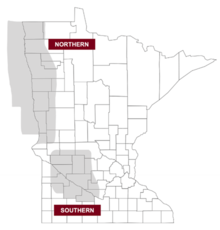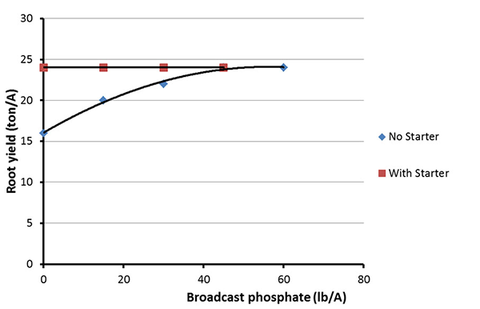The three grower-owned cooperatives in Minnesota and North Dakota vary in their payment programs. Some programs pay strictly on net sucrose quality, determined by sugarbeet root quantity and quality. Others incentivize higher quality sugarbeet roots. In both cases we determine quality by the concentration of sucrose and impurities in the root that need to be separated during the refining process.
Optimum sugarbeet production in Minnesota and North Dakota relies on a sound soil fertility program to enhance sugar beet quality.
Nitrogen
Nitrogen (N) is the most important nutrient when planning a fertilizer program for sugar beet production. Nitrogen status of the plant affects early growth and the quality of the sugarbeet at harvest. Early canopy closure allows the sugarbeet to make better use of sunlight and produce more sugar.
Excess nitrogen at or near the end of the growing season reduces sugarbeet quality, increases impurities, and reduces sucrose concentration. The highest quality sugarbeet will have nitrogen deficiency late in the growing season (about six weeks before harvest). The nitrogen fertilizer guideline will depend on the growing location.
Nitrogen guidelines for Minn-Dak and American Crystal Northern growing regions
130 lb. N per acre – NO3--N in a 4-ft. soil sample
For a 2-foot soil sample, target a rate of 100 pounds of total known available N per acre for the Minn-Dak and American Crystal growing regions.
Nitrogen guidelines for Southern Minnesota Beet Sugar Cooperative
110-150 lb. N per acre – NO3--N in a 4-ft. soil sample, accounting for soil organic matter
For a 2-foot soil sample, target a rate of 80 to 120 pounds of total known available N per acre for the Southern Minnesota Beet Sugar Cooperative growing region.
The amount of nitrogen fertilizer application to a sugarbeet crop should be based on the total N recommendation minus the nitrate-N (NO3--N) from a soil test.
The time of year at which the sample is taken is important. A soil sample for soil NO3--N should be taken when the soil temperature at a 6-inch depth has consistently dropped below 50 degrees F. Earlier sampling times will result in an inaccurate soil test value.
The depth to which to take the required soil test depends on the previous history of nitrogen management. It is recommended to take a soil sample to a depth of 4 feet if little knowledge exists on levels of NO3--N below 2 feet.
Research has indicated that soil samples for NO3--N should be taken from areas of 20 acres or less that are similar in landscape, soil type or previous management.
Field research shows that the source of the fertilizer does not matter if the source is applied in a way that will reduce loss. Nitrate fertilizer sources such as urea ammonium nitrate (28% or 32%) should not be applied in fall.
Split applications of nitrogen may improve fertilizer use efficiency for sugarbeets grown on sandy soils. Make sure your last application takes place before July 1. For soils that are not sandy, there is no need to split apply. Split nitrogen applications have not been shown to impact sugarbeet quality on medium- or fine-textured soils.
Current research has demonstrated that sugarbeet stand is reduced when urea is applied in spring. But sugarbeet root size increased with the reduction in stand. The result was no loss in root yield.
- Fall application of urea did reduce the risk for stand loss.
- Root yield and recoverable sucrose were not affected by timing of urea application.
- The reduced stand loss from spring application is not expected to reduce yield.
- Fall urea application is not considered a better practice than application in spring.
Nitrogen guidelines must be modified based on crop rotation and previous input management. The soil nitrate test is not accurate in situations where the previous crop is a legume (such as alfalfa) or manure applications have been made. We strongly recommend not to grow sugarbeets following alfalfa or where manure has been applied the previous year because the increase in nitrogen mineralized from organic N sources during the growing season can reduce sucrose concentration and recoverable sugar.
If you must use manure in the rotation, then you must manage it to take credit for the nitrogen mineralization that occurs from the manure. See our guidelines for manure application rates.
Past recommendations were not to grow sugarbeet after soybean but recent research in Southern Minnesota and Northwestern Minnesota indicate that if diseases such as rhizoctonia can be controlled, a good sugarbeet crop can be grown following soybean.
Research indicates:
- Growing sugarbeet after corn results in the least extractable sucrose per acre.
- Sugarbeet grown after spring wheat results in the greatest extractable sucrose.
- Intermediate results were found when growing sugarbeet after soybean.
- The previous crop did not affect the optimum N application.
Phosphorus
The sugarbeet plant uses phosphorus (P) for energy compounds. Phosphorus increases root yields in soils that are low in phosphorus while not affecting quality.
Since phosphorus is relatively immobile in the soil, recommendations are based on a soil sample to a depth of 6 to 8 inches. The phosphorus soil test does not measure the chemical form used by the plant as is the case with the nitrate test. The P soil test is only an index correlated to the crop response to P fertilizers in field trials.
The availability index (soil test) used for recommendations is dependent on the soil's pH. If the pH is less than 7.4, use a Bray P1 soil test. When the pH is 7.4 or greater, use the Olsen P soil test. Currently, the University of Minnesota and North Dakota State University do not support the Mehlich III soil test.
Our recommendations are based on broadcast applications of P fertilizer in fall or spring. Phosphate application guidelines are in pounds of P2O5 per acre for sugarbeet production based on soil test results in parts per million.
Phosphate application guidelines
| P2O5 rate to apply | Bray P1 test result | Olsen P1 test result |
|---|---|---|
| 80 lb./acre | 0-5 ppm | 0-3 ppm |
| 55 lb./acre | 6-10 ppm | 4-7 ppm |
| 35 lb./acre | 11-15 ppm | 8-11 ppm |
| 10 lb./acre | 16-20 ppm | 12-15 ppm |
| 0 lb./acre | 21+ ppm | 16+ ppm |
Research indicates that the use of a starter placement of fertilizer phosphorus with the sugarbeet seed is more efficient than a broadcast application. Phosphate application rates can be reduced up to one-half of the broadcast application rates and still produce similar yields.
Greenhouse work in Minnesota and Nebraska indicates that early sugarbeet growth is enhanced with starter placement of phosphorus, but there is a difference in the placement of the starter band.
Placement with the seed or two inches below the seed gets better results than to the more conventional placement of 2 inches to the side and 2 inches below the seed.
If you choose to use the seed placement option, be cautious with how much you apply. Applying greater than 5 pounds per acre of N + K2O in contact with the seed can reduce plant stand emergence.
The amount of P in contact with the seed has not been detrimental to plant stands. The occurrence of stand reduction increases with decreasing soil moisture condition at the time of planting.
The source of starter fertilizer is not a factor in getting a yield response. Dry and liquid starter fertilizer sources will perform similarly. The only difference is the amount that can be applied in contact with the sugarbeet seed.
Common starter phosphorus fertilizer sources and maximum amounts suggested for seed application
| Source | Name | Dry or liquid | Maximum amount to apply | Phosphate supplied |
|---|---|---|---|---|
| 10-34-0 | Ammonium polyphosphate | Liquid | 4 gal./acre | 16 lbs./acre |
| 18-46-0 | Diammonium phosphate | Dry | 28 lbs./acre | 13 lbs./acre |
| 11-52-0 | Monoammonium phosphate | Dry | 45 lbs./acre | 24 lbs./acre |
| 0-44-0 | Triple super phosphate | Dry | No limit | N/A |
Potassium
Potassium (K) is not a large concern in Minnesota because most of the soils where sugarbeet is grown are natively high in potassium. Currently, we do not recommend the use of a starter fertilizer with potassium because there is little research on the effect these sources have on sugarbeet growth and only a small amount of the sugarbeet growing areas need potassium fertilization.
Potassium is essential to sugarbeet production and is not mobile in the soil. The soil test is based on an ammonium acetate extraction on a surface soil sample that is 6 to 8 inches deep.
If the soil test is in the responsive range, placement can be similar to phosphorus except extreme caution should be exercised when placing in contact with the seed.
Potash guidelines for sugarbeet production
| Ammonium Acetate soil test | K2O to apply |
|---|---|
| K: 0-40 ppm | 110 lb./acre |
| K: 40-80 ppm | 80 lb./acre |
| K: 80-120 ppm | 50 lb./acre |
| K:120-160 ppm | 15 lb./acre |
| K:160+ ppm | 0 lb./acre |
Other nutrients
Research has not demonstrated a widespread need for secondary macronutrients and micronutrients for sugarbeet production. Deficiencies of magnesium, calcium or sodium are not expected in the Minnesota and North Dakota sugarbeet growing areas.
Sulfur (S) application has not been shown to increase root yield or effect recoverable sucrose on heavy textured soils with high organic matter.
- A response to sulfur is possible on sandy soils with soil organic matter concentrations of 2-3% or less.
- Research has not identified an optimal rate of sulfur to apply for sugarbeet grown on sandy soils.
- Applications of 10-25 pounds of sulfate sulfur can be made on a trial basis if a sulfur deficiency is suspected.
Recent research in the southern growing region showed the potential to reduce sugarbeet root yield with boron (B) rates over 3 pounds per acre.
- If a boron deficiency is suspected, apply boron at a rate of 1 to 2 pounds of boron per acre as a pre-plant broadcast application, or 0.15 to 0.25 pound per acre as a foliar before mid-June.
- There currently is no calibrated soil test to determine where a response to boron may occur.
Research on alfalfa has shown boron deficiencies are more likely on sandy soil with low organic matter concentrations when soil conditions are dry. If dry soils limit boron uptake, application of the nutrient may still not affect plant growth or yield even though boron concentration in leaf tissue is considered low.
Sugarbeet response to manganese (Mn) has not been widely studied for sugarbeet in Minnesota and North Dakota.
High pH soils can reduce the availability of manganese in the soil, but research has seldom shown a benefit to manganese application in crops prone to a manganese deficiency.
Treatment with fungicides for Cercospora leaf spot control may contain manganese, copper and zinc, which eliminates the need to apply separate applications of these nutrients for sugarbeet.
Nutrient concerns for crops following sugarbeet
Work from North Dakota State University and the University of Minnesota’s Northwest Research and Outreach Center indicate that nitrogen credits should be given for nitrogen in the sugarbeet tops for crops such as small grains and corn grown after the sugarbeet crop in rotation. If sugarbeet top growth is lush and green, the credit could be as great as 70 pounds N per acre.
Research in southern Minnesota has not confirmed the N credit of sugarbeet tops for corn production following sugarbeet in the rotation. If you are growing corn following sugarbeet in the rotation, you should consider using a starter application of 40 pounds phosphate per acre. If the EDTA zinc soil test is low, also include 2 pounds of zinc in the starter.
Reviewed in 2023



